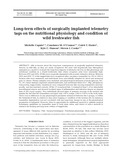| dc.identifier.citation | Caputo, Michelle, Constance M. O’Connor, Caleb T. Hasler, Kyle C. Hanson, and Steven J. Cooke. "Long-term effects of surgically implanted telemetry tags on the nutritional physiology and condition of wild freshwater fish." Diseases of Aquatic Organisms 84 (2009): 35-41. DOI: https://doi.org/10.3354/dao02025. | en_US |
| dc.description.abstract | Little is known about the long-term consequences of surgically implanted telemetry
devices on wild fish, as they are rarely recaptured. We used wild largemouth bass Micropterus salmoides as a model to evaluate the long-term impacts of telemetry devices on fish physiology and nutritional condition in a closed freshwater lake where recapture rates were reasonably high. Between 2003 and 2005, 68 fish were surgically implanted with acoustic telemetry devices. Between 2005 and 2008, 17 of the tagged fish were recaptured after carrying a transmitter for 335 to 1402 d. Incision sites were examined, and individuals were non-lethally sampled for blood and measured prior to release. Plasma samples were analysed, and physiological measures of stress (glucose, Na+, Cl–, K+), tissue damage (aspartate aminotransferase), and nutritional status (Ca++, Mg+, phosphorus, total protein, triglycerides, cholesterol) were compared between fish carrying transmitters and temporally- and size-matched controls. Of the 17 recaptured fish, 3 retained at least 1 of the absorbable monofilament sutures and showed localised signs of inflammation and infection despite an elapsed time of 362 d post surgery. Five individuals showed signs of pressure necrosis at the incision site despite the fact that the transmitters averaged only 1.89% (range: 0.84 to 3.59%) of the body mass. There was no difference in any physiological parameter measured between the 2 groups, or within the telemetered fish, in relation to days since tagging or condition of the incision site. In summary, transmitter implantation was not correlated with any long-term change in any of the physiological parameters investigated. However, there is opportunity for additional research to optimise surgical techniques, guidelines on transmitter mass to body mass ratios, and choice of suture material to enhance the healing and long-term welfare of tagged fish. | en_US |

